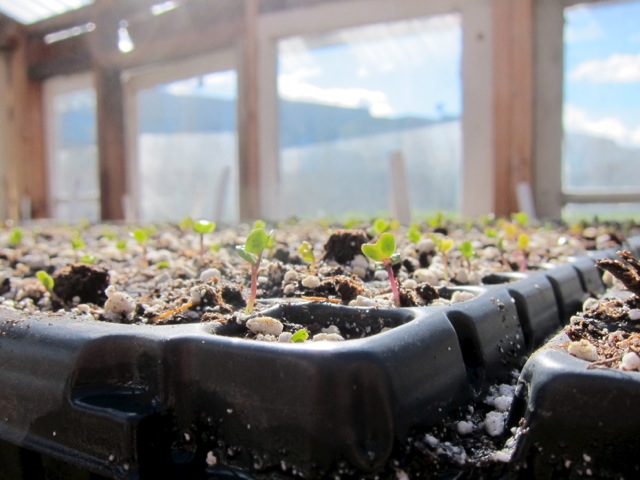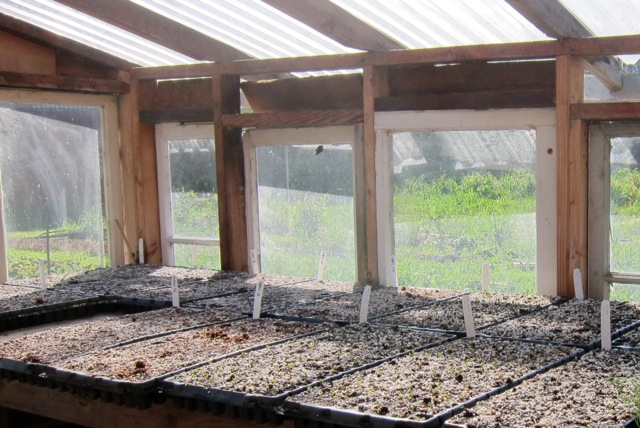part-time farming
February 8th, 2013 by caitlynSpring is here! At least at the farm anyway. The compost delivery is scheduled to arrive next week, a new large patch of strawberries is planted, the greenhouse is cleaned up and packed full of freshly seeded trays, and we’re getting the cover cropped beds turned in and pre-mulched while they await the big brassica planting later this spring.
I feel good about this season, because after a bit of winter distance from last year’s challenging ups and downs, we’ve decided that the next phase of this experiment is to scale back a bit. Rather than spread ourselves thin trying a whole plethora of marketing outlets and crop experiments, we’re going to hone in. We’ll shave our planting plan down to crops we’ve learned sell consistently well and for a decent price, and we’ll use the newly freed up bed space for more perennials and low maintenance crops we love like strawberries, cardoon, chayote, rhubarb and more flowers. We’ll start the season with only restaurant sales (a reliable and efficient outlet for us), and we’ll move slowly from there.
While we’re proud of what we’ve created so far – a functioning urban farm business that covers all its costs and makes a meager profit – we’re trying to maintain some honest perspective about what is working and what is not. Farming anywhere is hard, all-consuming work. Food prices are generally low compared to the amount of labor and resources that goes into its production, and the amount of task-juggling, experimenting, and constant troubleshooting that goes into running a production farm is never ending. This wasn’t a surprise to us of course, and the importance of experiencing and sharing these realities, particularly with our urban supporters as an audience, has been an inspiring motivation from the beginning. Neither of us are afraid of hard work, in fact I’d say we are both drawn to it, and both of us started this project privileged enough to be able to feel comfortable with small, unpredictable salaries. But this past year, due to the frighteningly high cost of living in San Francisco, our still tenuous land tenure situation, and the tug and pull of personal goals and needs outside of the farm, we found ourselves at times more tired, physically and emotionally, than we had really expected.
Of course there were great accomplishments: some beautifully successful crops, a small crew of incredible and devoted volunteers, inspiring emails from afar, and a year’s worth of notes and observations about farming on this piece of land. However, there are parts of this project that have felt so unfortunately neglected this past year. Keeping up full time with the farm’s steadily spinning wheels has left little time for the processing, documenting, and reflecting that we were so inspired to do from the beginning. Yes, San Francisco and many cities like it need farms. And gardens. We need as much food production within city limits as we can fit — we need small backyard veggie plots, educational gardens, community gardens, free food sharing programs, spontaneous farms without permission, aboveground farms that confront and push all the legal boundaries, nonprofit farms and commercial farms alike. We need them all! But, from any of these farms, what feels just as important as the nutritious food and the empowerment a community experiences from growing it together, is the dialogue and reflection that the farms can generate. The symbolic rootedness to the large, endangered, complex food system that is out there beyond our city limits, and the ways we all fit into it.
We’ve had high hopes for this farm to be a contribution to this very kind of connectedness. We want to talk openly about our financial figures and business plans — the pages that, in the name of competition, are so typically guarded by businesses — so that others can consider this kind of farming (and quite possibly find ways to do it better). We want to write more about the politics of food prices, and the complicated hip foodie scene we are right in the middle of here in SF. We want to read more from other farmers and activists. We want to recommend articles as we come across them, link you to related news pieces and relevant discussions taking place. We want to take more photos of the farm, and share growing tips and techniques we’re picking up along the way. We want to make a living growing as much food as we can, but even more importantly we want the process of growing this food to be an earnest contribution to a conversation that is so much larger.
It’s ambitious, and after this past year I really wonder how much we can actually do all at once. But, in an attempt to get closer, we’ll seek balance and try our hands at part-time farming. It’ll be the next step in this ongoing experiment — a restructuring of our time on and off the farm. We’re also going to relieve some of the financial pressure we’re feeling by increasing our off-farm work (I’m making time for more sign painting and lettering work, and Brooke has some new illustration projects underway). We want to work hard, but we want the hard work to feel balanced and meaningful and relevant to what this project has been about from the beginning.


